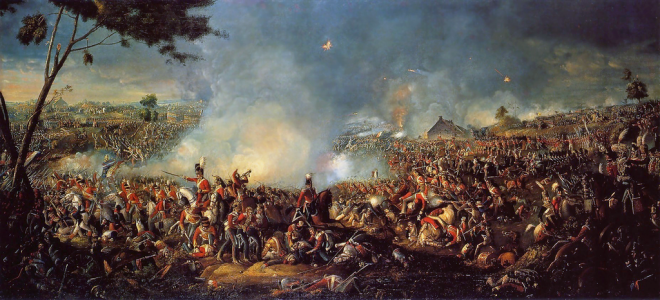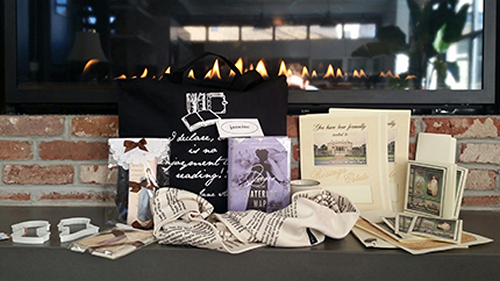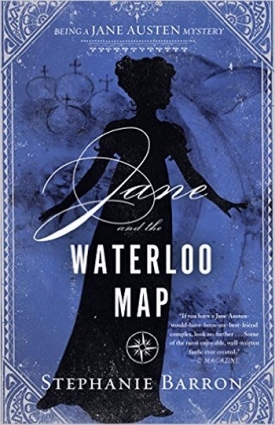Amateur sleuth Jane Austen returns in Jane and the Waterloo Map,
the thirteenth novel in Stephanie Barron’s delightful Regency-era mystery series.
Gentle Readers: Today Jane Austen in Vermont is taking part in the ‘Jane Austen and the Waterloo Map’ blog tour that began on February 2, 2016 (see other tour stops below). Ms. Barron has done it again! – this time taking us into the Battle of Waterloo, but not before presenting our Jane with a body in the Carlton House Library! Read here an except from Chapter 8, followed by the details for the Giveaway – you can comment here or any of the other blog posts until February 29th.
***************************
November, 1815. The Battle of Waterloo has come and gone, leaving the British economy in shreds; Henry Austen, high-flying banker, is about to declare bankruptcy—dragging several of his brothers down with him. The crisis destroys Henry’s health, and Jane flies to his London bedside, believing him to be dying. While she’s there, the chaplain to His Royal Highness the Prince Regent invites Jane to tour Carlton House, the Prince’s fabulous London home. The chaplain is a fan of Jane’s books, and during the tour he suggests she dedicate her next novel—Emma—to HRH, whom she despises. However, before she can speak to HRH, Jane stumbles upon a body—sprawled on the carpet in the Regent’s library. The dying man, Colonel MacFarland, was a cavalry hero and a friend of Wellington’s. He utters a single failing phrase: “Waterloo map” . . . and Jane is on the hunt for a treasure of incalculable value and a killer of considerable cunning.
And now….
AN EXCERPT FROM CHAPTER 8:
In which Jane discusses the Battle of Waterloo with one of its survivors,
Lieutenant James Dunross of the Scots Greys.
“I did wonder whether the Colonel’s final words had any connexion to his valor on the field at Waterloo.” I looked at the Lieutenant rather than my hostess’s rigid form. “I have heard him described as a Hero. Would it trouble you to speak of him—or might I persuade you to recount his actions on that glorious day?”
There was the briefest pause.
“James?” Miss MacFarland queried in a lowered tone, her gaze fixed on the glowing coals.
“My dear,” he replied.
“Will it distress you?”
“Naturally. But as I expect to be hearing of Waterloo for the rest of my life, I had as well become accustomed.” The Lieutenant’s aspect was light, but his voice betrayed his distaste. “I should not use the word glory, however, to describe it. Carnage is more apt.”
“No,” Miss MacFarland protested. She turned impulsively to face us. “It shall always be a day of glory to me, because you and Ewan were spared! I cannot tell you how incomprehensible it is, Miss Austen, that my brother survived that battle—only to end in the fashionable desert of Carlton House. Incomprehensible!”
“The Colonel belonged to the Scots Greys, I believe?”
“He began military life in an hussar regiment, and saw years of active service in the Peninsula; but being better suited to heavy dragoon work, exchanged two years ago into the Greys. That is how we came to be acquainted with Lieutenant Dunross—James served in the regiment under my brother.”
The gentleman forced himself heavily to his feet, and crossed with the aid of his cane to the draped window. He pulled aside the dark blue curtain and leaned into the casement, staring expressionlessly down at Keppel Street.“Are you at all familiar with the course of the battle?” Miss MacFarland asked.“What little I learned from published accounts.”
“Then you will know that the cavalry was commanded by Lord Uxbridge.”
As who did not? Uxbridge had cut a dash among the Great for most of his life: He was an earl as well as a general; head of the Paget family; a darling of the ton; and Wellington’s reputed enemy. A few years since, Uxbridge ran off with the Duke’s sister-in-law, and embarrassed all their acquaintance. Divorce and outrage are nothing new to people of Fashion, however; and tho’ Uxbridge and Wellington might not sit down to whist together, once battle was joined with Napoleon, one was in command of the other’s cavalry. Some ten brigades, in fact.
“In the early afternoon of that wearing day, Wellington’s left was under serious attack from the French batteries,” Miss MacFarland said. I collected from her unvaried tone that she had told this story—or heard it told by her brother—many times. “General Picton was killed, and shells were exploding with horrific effect all along the British line. Our troops were giving way under the assault of d’Erlon’s columns. Uxbridge saw it as Wellington could not, being far down the right. The Earl threw Lord Edward Somerset and the Household Brigade into the thick of the fight, then galloped off to the Union Brigade. This is composed, as perhaps you may know, of three regiments: the English, or Royals; the Scots Greys; and the Irish, or Inniskillings.”
“Ah,” I managed. I had never thought to consider which regiments comprised the Union Brigade.
“Sir William Ponsonby was in command.”
Another man of Fashion. The Ponsonbys had spawned Lady Caroline Lamb, one of most outrageous ladies I have ever encountered.
“And above Ponsonby was Uxbridge,” I said encouragingly, having got it all straight. “So Somerset and Ponsonby and Uxbridge—who might normally have met peaceably in a ballroom—charged off together on horseback to slaughter the French.”
“Indeed. Or at least, their gun batteries.” Miss MacFarland glanced almost unwillingly at Lieutenant Dunross, but the silent figure by the parlour window gave no sign that he was attending to our conversation.
“The Greys were supposed to be held in reserve,” she continued. “But in fact they attacked the longest—well after the Royals and the Inniskillings had given up.”
“Of their own volition? –Without waiting for the command to charge?”
“No Scotsmen would be left in the rear while the English and Irish attack,” Miss MacFarland said proudly. “And indeed, the Union Brigade succeeded in their object so well that the French were turned.”
“For a little while, perhaps,” James Dunross tossed over his shoulder. “A half hour, even. But as is so often true in the smoke and confusion of battle, the hunters became the hunted.”
“I am sure that Ewan regarded that charge as having won the day,” Miss MacFarland argued.
“So he may have done! But he was wrong, Georgie. The battle was won by Blücher and his Prussians, not the Scots Greys.” He turned abruptly from the window and stumped back to us on his cane, his countenance alight with anger. “You must apprehend, Miss Austen, that most of our commanders and cavalrymen know nothing of military science. Excellent fellows, to be sure—Uxbridge was an hussar in his youth, and could not be called green—but we are gentlemen first and soldiers a distant second. What we know of cavalry manoeuvres was learnt on the hunting field. We are apt to get carried away by our own daring, as tho’ a confrontation with the French were a day’s hunting with the Quorn. Which is rather what happened at Waterloo.”
I stared at him frowningly. “You were distracted by a fox?”
“In our enthusiasm to have at Buonaparte, we charged too far,” Dunross explained, “and then could not get back again to the British lines. Most of us had never been in battle before. Ponsonby was unhorsed—he’d left his best charger in the rear because he could not bear to expose so expensive a mount to enemy fire. When the hack he rode into battle failed him, he was shot dead where he stood. The French cavalry counterattacked with Lancers. Do you know of them?”
I shook my head.
“Quite a new thing in military circles, but utterly terrifying. They carry something like a jousting stick and can stab anything on two or four legs to death. One of them stabbed me as I lay on the ground, unhorsed after that celebrated charge.”
“The hunters became the hunted, as you say?”
He smiled thinly. “Our cavalry were broken up, cut off, surrounded, and destroyed.”
I glanced at Miss MacFarland. Her expression was grim, as tho’ it were physical pain to hear Dunross speak.
“You will admit, James, that the Greys showed the most dramatic charge of all, in the midst of a sunken lane between hedges, where they sabered the French to pieces?” she cried. “You will admit that they seized one of Napoleon’s Eagles–the most dreadful shame a Frenchman may know?”
“Certainly,” he returned. “And then the French threw themselves down and pretended to surrender to us. Being honourless rogues, however, they stood up and fired on us as we approached to disarm them.”
She threw up her hands. “I wonder you regard even my brother as worthy of your respect, James,” she cried.
“I must,” he returned. “I owe him my life. Such as it is.”
******************
Grand Giveaway Contest!!
Win One of Three Fabulous Prizes
In celebration of the release of Jane and the Waterloo Map, Stephanie is offering a chance to win one of three prize packages filled with an amazing selection of Jane Austen-inspired gifts and books!
To enter the giveaway contest, simply leave a comment on any or all of the blog stops on Jane and the Waterloo Map Blog Tour starting February 02, 2016 through 11:59 pm PT, February 29, 2016. Winners will be drawn at random from all of the comments and announced on Stephanie’s website on March 3, 2016. Winners have until March 10, 2016 to claim their prize. Shipment is to US addresses. Good luck to all!
Further reading:
- Stephanie Barron’s Facebook page: https://www.facebook.com/Stephanie-Barron-170406529715164/?fref=ts
- Stephanie Barron’s Goodreads page: https://www.goodreads.com/author/show/17764.Stephanie_Barron?from_search=true&search_version=service
- Twitter handles: @SBarronAuthor; @Soho_Press
- Twitter hashtags: #WaterlooBlogTour, #JaneAusten, #HistoricalMystery, #RegencyMystery, #Reading, #AustenesqueMystery #Austenesque #Giveaway
***************
A review from Library Journal:
“Barron deftly imitates Austen’s voice, wit, and occasional melancholy while spinning a well-researched plot that will please historical mystery readers and Janeites everywhere. Jane Austen died two years after the events of Waterloo; one hopes that Barron conjures a few more adventures for her beloved protagonist before historical fact suspends her fiction.”
The Blog Tour: For more about Jane and the Waterloo Map, you can visit and comment on these other blogs throughout the month of February – there are reviews, interviews, guest blogs, and more excerpts, plus the fabulous giveaway opportunity. Join the fun!
JANE AND THE WATERLOO MAP BLOG TOUR SCHEDULE:
- February 02 My Jane Austen Book Club (Guest Blog)
- February 03 Laura’s Reviews (Excerpt)
- February 04 A Bookish Way of Life (Review)
- February 05 The Calico Critic (Review)
- February 06 So Little Time…So Much to Read (Excerpt)
- February 07 Reflections of a Book Addict (Spotlight)
- February 08 Mimi Matthews Blog (Guest Blog)
- February 09 Jane Austen’s World (Interview)
- February 10 Just Jane 1813 (Review)
- February 11 Confessions of a Book Addict (Excerpt)
- February 12 History of the 18th and 19th Centuries (Guest Blog)
- February 13 My Jane Austen Book Club (Interview)
- February 14 Living Read Girl (Review)
- February 14 Austenprose (Review)
- February 15 Mystery Fanfare (Guest Blog)
- February 16 Laura’s Reviews (Review)
- February 17 Jane Austen in Vermont (Excerpt)
- February 18 From Pemberley to Milton (Interview)
- February 19 More Agreeably Engaged (Review)
- February 20 Babblings of a Bookworm (Review)
- February 21 A Covent Garden Gilflurt’s Guide to Life (Guest Blog)
- February 22 Diary of an Eccentric (Review)
Stephanie Barron was born in Binghamton, New York, the last of six girls. She attended Princeton and Stanford Universities, where she studied history, before going on to work as an intelligence analyst at the CIA. She wrote her first book in 1992 and left the Agency a year later. Since then, she has written fifteen books. She lives and works in Denver, Colorado. Learn more about Stephanie and her books at her website, visit her on Facebook and Goodreads.
All the FACTS:
- Title: Jane and the Waterloo Map (Being a Jane Austen Mystery)
- Author: Stephanie Barron
- Tour Dates: February 02 – February 22, 2016
- Genre: Regency-era Mystery/ Historical Mystery/Austenesque Mystery
- Publisher: Soho Crime (February 02, 2016)
- Hardcover ISBN: 978-1616954253
- eBook ISBN: 978-1616954260
- Author’s website: http://www.stephaniebarron.com/books.php
- Blog Tour page: http://stephaniebarron.com/blog-tour.php
Purchase options:
- Amazon Link: http://www.amazon.com/Jane-Waterloo-Being-Austen-Mystery/dp/1616954256/ref=tmm_hrd_swatch_0?_encoding=UTF8&qid=1451778725&sr=8-1
- Barnes & Noble Link: http://www.barnesandnoble.com/w/jane-and-the-waterloo-map-stephanie-barron/1121860459?ean=9781616954253
- Book Depository Link: http://www.bookdepository.com/Jane-and-the-Waterloo-Map-Stephanie-Barron/9781616954253
- IndieBound Link: http://www.indiebound.org/book/9781616954253
- Goodreads Link: https://www.goodreads.com/book/show/25489249-jane-and-the-waterloo-map
- iTunes Link: https://itunes.apple.com/us/book/jane-and-the-waterloo-map/id993475556?mt=11
- Publishers Page: http://sohopress.com/books/jane-and-the-waterloo-map/
Amazon | Barnes & Noble | Book Depository | Indiebound | Goodreads







Thank you for this wonderful novel.
LikeLike
I love the inclusion of battle history, though there is definitely a line one doesn’t cross for their audience. As in any case, the author must understand the big picture to show even a small portion of it. This is so nicely done!
LikeLike
Yes it is – Stephanie is very good on her historical details and Austen’s actual chronology – whatever will she do come 1817…does she change reality for fictional ends??
LikeLike
I love the excerpt!
LikeLiked by 1 person
Sounds interesting. Carlton House, the battle of Waterloo and Jane as a sleuth. Can’t go wrong. Blucher did win the day.
I actually think Napoleon was a much better person than The Duke of Wellington who was pretty nasty all in all.I found an account by a British naval captain, who met Napoleon in exile on St Helen far out in the Atlantic. I felt inspired by his account of Napoleon as a person. I could see why his troups adored him.
LikeLike
Tony, I am stunned! – you would be speaking French right now rather than the Queen’s English! Whatever can you mean praising Napoleon and demeaning Wellington – I think duct tape is in order for your blasphemy!
LikeLiked by 1 person
On The National Army museum website you can access all sorts of original documents. I found a report by Captain Hall of HMS Lyra who called into St Helena while Naploeon was there. He reported his meeting . Captain Hall was obviously overawed at first by the great man who put him completely at ease. Napoleon comes across as interested in people. He wanted to know from Hall about the religions and cultures of various tribes he had come across on his explorations. Napoleon was intensely interested in religious beliefs and social mores.He came across as passionate about things. Hall fell under his spell and felt that Napoleon treated him as an equal. Reading it made me like Napoleon.
LikeLike
Fabulous excerpt! I can’t wait to read this series! :)
LikeLiked by 1 person
I love all the historical bits in this book! When authors combine fiction with real events, I am totally captivated. This series does it superbly. Thanks for sharing Deb.
LikeLike
Thanks for including me in the blog tour Laurel Ann! I love how she starts it off imagining Austen’s actual visit to the Carlton House Library – and finding a body there seems exactly the right thing for a tale of intrigue…
LikeLike
Another excerpt! This is proving to be quite the blog tour! Thanks, I am looking forward to the new book!
LikeLike
Great excerpt! Can’t wait to read this!
LikeLike
So many things to love about this series: history, mystery and Jane Austen. Have read from the first and anxiously awaiting newest installment.
LikeLike
Yes, Stephanie, they are terrific – think you will like this one very much!
LikeLike
I am amazed at the amount of historical research that must have gone into writing this novel!
LikeLike
Interesting excerpt. I don’t know much about Waterloo, but this makes me want to read up on it to better understand the motivations of the characters.
LikeLike
Actually one of the best accounts of Waterloo was written by of all people Georgette Heyer! An Infamous Army – her research was so exact her text has been used in teaching about the battle…highly recommend it as an intro at least. Countless other resources of course – you could spend the rest of your life studying it!
Thanks for stopping by – good luck in the drawing – but if you don’t win, you must get this latest book in Stephanie’s fabulous series!
LikeLike
Very excited about this book! I like the way Stephanie Barron creates her setting and characters!
LikeLike
I would like to enter. :)
LikeLike
What a wonderful joining of fiction with fact. The elements of history intermingled within the story add depth. It helps the audience believe that Jane is truly the author. Well done.
LikeLike
Thank you for sharing the excerpt of this book, it makes me want to read it that much more. I am new to your blog and have enjoyed visiting.
LikeLike
Thank you Book Aunt – glad you found us here and good luck in the drawing!
LikeLike
Excellent excerpt! Thanks for sharing. I can’t wait to read the rest of this book. ^-^
LikeLike
Sounds good. I like historical mysteries and sometimes you can find good Regency ones. Usually I read the Victorian ones.
LikeLike